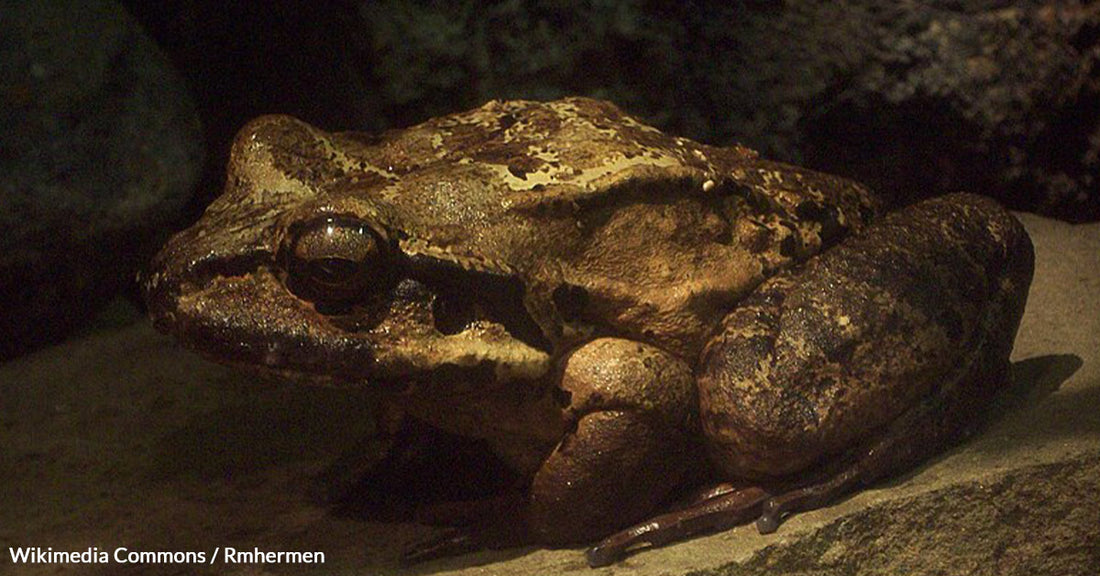7th Annual Holiday Toy & Book Event Help make the holidays brighter this year!
The Vanishing Mountain Chicken Frog May Be The Fastest Case Of Extinction Ever Recorded
Matthew Russell
The Caribbean island of Dominica was once a place where the sound of the male mountain chicken frog's call filled the air. These frogs were so numerous that they were cooked as a national dish, a delicacy enjoyed by both locals and tourists. However, fast forward two decades, and this once-prolific species has virtually vanished from the island.
The startling speed of this decline has left scientists in shock, as it ranks among the fastest recorded extinctions of a wild animal in history.
 Photo: Wikimedia Commons / TimVickers, License: Public Domain
Photo: Wikimedia Commons / TimVickers, License: Public DomainThe mountain chicken frog, Leptodactylus fallax, is one of the world's largest frog species.
The Vanishing Mountain Chicken Frog
The mountain chicken frog, scientifically known as Leptodactylus fallax, was cherished for its large size, growing up to 20 centimeters in length and weighing over a kilogram, The Guardian reports. It played a crucial role in Dominica's ecosystem as a top predator, consuming insects, small mammals, snakes, and even other frogs.
The rapid decline of this species began with the emergence of a chytrid fungus, which infects amphibians through their skin. According to the Zoological Society of London, this fungus first appeared on Dominica in 2002, and within just 18 months, it had wiped out 80% of the island's mountain chicken frogs.
Despite the warnings, the nearby island of Montserrat failed to implement strict quarantine measures, allowing the fungus to infect the frog population there in 2009, reports Flora & Fauna International.
 Photo: Wikimedia Commons / Podolski24, License: CC BY-SA 4.0 DEED
Photo: Wikimedia Commons / Podolski24, License: CC BY-SA 4.0 DEEDMountain chicken frogs are known for their large size, growing up to 20 centimeters in length.
The Future Of A Dwindling Species
Amid this crisis, there was a glimmer of hope when some of the mountain chicken frogs were found to be naturally resistant to the chytrid fungus, The Guardian reports. But this hope was short-lived as Hurricane Maria, the most powerful hurricane ever recorded to hit Dominica, struck in 2017. The hurricane left more than 90% of the remaining frog population devastated.
Today, the mountain chicken frog faces a bleak future, with less than a few dozen left alive in the wild, Study Finds reports. While there are zoo collections of the species from Montserrat, they are not resistant to the chytrid fungus, limiting their potential for reintroduction.
The resistant Dominica population now clings to existence in just two small, unprotected habitats, Tech Times reports.
Additionally, the effects of climate change, including drying weather patterns, are further hindering efforts to save the species. Despite these challenges, some experts remain cautiously optimistic.
 Photo: Zoo overnight 070, Wikimedia Commons / Rmhermen, License: CC BY-SA 3.0 DEED
Photo: Zoo overnight 070, Wikimedia Commons / Rmhermen, License: CC BY-SA 3.0 DEEDThe mountain chicken frog's unique name is also linked to its chicken-like squawking alarm call.
A Fragile Reminder
The plight of Dominica's mountain chicken frog serves as a stark reminder of the fragility of our planet's biodiversity. This ecological calamity demonstrates how quickly wildlife can be damaged and destroyed. From invasive diseases to extreme weather events, ecological threats can jeopardize the survival of vulnerable species sooner than we might think.
With amphibians often serving as indicators of environmental change, their declining populations can further be seen as warning signs of broader ecosystem disruptions. Their struggles foreshadow potential impacts on humans in the future, making their preservation not only an ethical responsibility but also a matter of self-preservation.
In the face of rapid extinction, scientists and conservationists continue to work tirelessly to save the mountain chicken frog. While the challenges are immense, the hope of preventing its extinction persists. The mountain chicken frog may yet find a way to survive and rebound, serving as a testament to the resilience of nature and the unwavering commitment of those dedicated to its preservation.
Sign our petition and be a part of the movement to protect and conserve our native amphibians.

